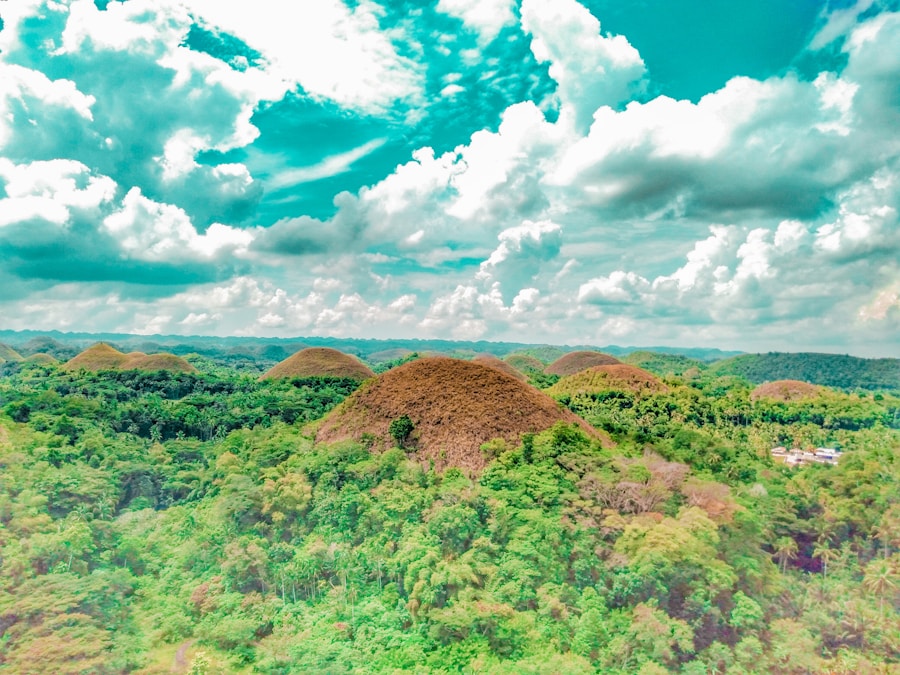Download links
How to install The Mysterious Beauty of Chocolate Hills APK?
1. Tap the downloaded The Mysterious Beauty of Chocolate Hills APK file.
2. Touch install.
3. Follow the steps on the screen.
Description
The Chocolate Hills, a geological wonder located in the Bohol province of the Philippines, are a striking natural formation that has captivated both scientists and tourists alike. These hills, numbering over 1,200, rise dramatically from the surrounding landscape, creating a surreal panorama that resembles a sea of chocolate mounds. The origin of these hills is attributed to a combination of geological processes, primarily limestone erosion and the uplift of coral deposits.
Formed during the Pleistocene epoch, the hills are believed to have been shaped by the dissolution of limestone by rainwater, which gradually eroded the softer rock layers, leaving behind the distinctive conical shapes we see today. The unique topography of the Chocolate Hills is further enhanced by the region’s climatic conditions. During the dry season, the grass that covers these hills turns a rich brown hue, giving them their name.
This seasonal transformation is a key aspect of their allure, as visitors flock to witness the hills’ striking appearance against the backdrop of a clear blue sky. The geological history of the area is complex; it is thought that the hills were once part of an extensive coral reef system that thrived millions of years ago when the region was submerged under water. As tectonic activity raised the land above sea level, these coral formations were exposed and subsequently shaped by natural forces, resulting in the iconic landscape that we admire today.
Key Takeaways
- The Chocolate Hills in the Philippines are a geological formation consisting of at least 1,260 individual hills, which are believed to be the weathered remnants of ancient limestone deposits.
- The unique flora and fauna of the Chocolate Hills include a variety of plant and animal species, some of which are endemic to the region and can only be found within the hills.
- The Chocolate Hills hold cultural and historical significance for the Filipino people, with local legends and folklore attributing their formation to the tears of a giant who fell in love with a mortal woman.
- Local myths and legends surrounding the Chocolate Hills include stories of giants and forbidden love, adding to the mystical allure of the landscape.
- The best ways to experience and explore the Chocolate Hills include hiking, bird watching, and visiting the nearby viewing deck for panoramic views of the hills and surrounding countryside.
- Conservation and preservation efforts for the Chocolate Hills are ongoing, with initiatives focused on sustainable tourism, reforestation, and the protection of the unique flora and fauna within the area.
The Unique Flora and Fauna of Chocolate Hills
Adapting to the Environment
Grasses dominate the landscape, particularly during the dry season when they turn brown, but during the rainy season, they flourish into vibrant green carpets. This seasonal shift not only contributes to the visual appeal of the hills but also supports a range of wildlife that thrives in this dynamic environment.
Unique Inhabitants
Among the fauna found in and around the Chocolate Hills are several endemic species that are unique to Bohol. The Philippine tarsier, one of the smallest primates in the world, is a notable inhabitant of this region. With its large eyes and distinctive appearance, the tarsier has become an emblematic figure for Bohol’s wildlife conservation efforts.
A Rich Tapestry of Life
These nocturnal creatures are primarily insectivorous and rely on the dense vegetation for both shelter and food. Additionally, various bird species can be spotted in this area, including the Philippine eagle and several types of kingfishers, which add to the rich tapestry of life that characterizes this unique ecosystem.
The Cultural and Historical Significance of Chocolate Hills

The Chocolate Hills hold significant cultural and historical importance for the people of Bohol. They are not merely a natural wonder; they are deeply woven into the local identity and heritage. The hills have been recognized as a national geological monument and are included in various tourism campaigns aimed at promoting Bohol as a prime destination for both local and international travelers.
Their unique shape and beauty have inspired countless stories, artworks, and cultural expressions throughout history. Historically, the Chocolate Hills have also served as landmarks for navigation and orientation for local communities. They are often referenced in local folklore and traditions, symbolizing resilience and strength in the face of adversity.
The hills have become a source of pride for Boholanos, representing not only their natural heritage but also their cultural resilience against colonial influences and natural disasters. This connection to their land fosters a sense of stewardship among local residents, who actively participate in conservation efforts to protect this iconic landscape for future generations.
The Local Myths and Legends Surrounding Chocolate Hills
| Myth or Legend | Description |
|---|---|
| The Legend of Arogo | Arogo, a giant who fell in love with a mortal woman, cried tears that formed the Chocolate Hills when she died. |
| The Legend of Two Fighting Giants | Two giants fought for days, throwing rocks and sand at each other, and the Chocolate Hills were formed from the aftermath of their battle. |
| The Legend of the Weeping Giant | A giant named Magaul mourned the death of his beloved and his tears formed the Chocolate Hills. |
| The Legend of the Chocolate Hills as Droppings | A giant carabao (water buffalo) came to Bohol and ate all the crops, leaving behind droppings that eventually turned into the Chocolate Hills. |
The allure of the Chocolate Hills extends beyond their physical beauty; they are steeped in local myths and legends that add layers of intrigue to their existence. One popular legend tells of two giants who engaged in a fierce battle, hurling boulders at each other across the landscape.
This tale not only explains their unusual formation but also reflects the rich oral tradition of storytelling that is prevalent in Filipino culture. Another legend speaks of a giant named Arogo who fell in love with a mortal woman named Aloya. When Aloya passed away, Arogo was heartbroken and wept for her loss.
His tears formed the hills as they fell to the ground, creating a landscape that symbolizes his eternal sorrow. Such stories serve to connect the natural world with human emotions and experiences, illustrating how local communities interpret their environment through narrative. These myths contribute to the cultural fabric of Bohol, making visits to the Chocolate Hills not just an exploration of nature but also an immersion into local lore.
The Best Ways to Experience and Explore Chocolate Hills
Experiencing the Chocolate Hills is an adventure that can be tailored to suit various interests and preferences. One of the most popular ways to explore this stunning landscape is by visiting designated viewpoints that offer panoramic vistas of the hills. The most famous viewpoint is located at Chocolate Hills Complex in Carmen, where visitors can climb a series of stairs to reach an observation deck that provides breathtaking views over the undulating terrain.
This vantage point allows for stunning photography opportunities, especially during sunrise or sunset when the light casts dramatic shadows across the hills. For those seeking a more immersive experience, guided tours can be arranged that include hiking or biking through the surrounding areas. These tours often provide insights into the local ecology and geology while allowing participants to engage with nature up close.
Additionally, some tour operators offer ATV rides through designated trails around the hills, providing an exhilarating way to navigate this unique landscape while enjoying its natural beauty. Engaging with local guides can enhance this experience further; they often share stories about the hills’ significance and help visitors appreciate their cultural context.
The Conservation and Preservation Efforts for Chocolate Hills

As a natural treasure, the Chocolate Hills face various environmental challenges that necessitate ongoing conservation efforts. The increasing influx of tourists poses risks such as littering, soil erosion, and habitat disruption for local wildlife.
One significant initiative involves establishing protected areas around the hills to safeguard their ecological integrity. This includes enforcing regulations on waste management and limiting access to sensitive areas during peak tourist seasons. Educational programs aimed at raising awareness about environmental conservation among both locals and visitors have also been introduced.
These programs emphasize responsible tourism practices, encouraging visitors to respect nature and minimize their impact on this fragile ecosystem. In addition to these efforts, community involvement plays a crucial role in conservation strategies. Local residents are often engaged in monitoring activities and are encouraged to participate in reforestation projects aimed at restoring native vegetation around the hills.
By fostering a sense of ownership among community members regarding their natural heritage, these initiatives not only help protect the Chocolate Hills but also strengthen local identity and pride in their unique environment.
If you’re interested in exploring more unique natural wonders like the Chocolate Hills, you may want to check out an article on the future of fisheries in Indonesia. This article discusses the perspectives of fishermen on the future of the fishing industry, providing insight into how environmental changes and technological advancements may impact marine life and the livelihoods of those who depend on it. It’s a fascinating look at how human activities can shape the natural world around us.
FAQs
What are the Chocolate Hills?
The Chocolate Hills are a geological formation located in the Bohol province of the Philippines. They are a group of at least 1,260 cone-shaped hills spread over an area of more than 50 square kilometers.
Why are they called the Chocolate Hills?
During the dry season, the grass covering the hills turns brown, giving them a chocolate-like appearance. This is where the name “Chocolate Hills” comes from.
How were the Chocolate Hills formed?
The exact formation process of the Chocolate Hills is still a subject of debate among geologists. One theory suggests that they are the weathered formations of a marine limestone on top of an impermeable layer of clay. Another theory proposes that they are the result of the uplift of coral deposits and the action of rainwater and erosion.
Are the Chocolate Hills a popular tourist attraction?
Yes, the Chocolate Hills are one of the most popular tourist attractions in the Philippines. Visitors can enjoy panoramic views of the hills from observation points and platforms, and there are also opportunities for activities such as hiking and zip-lining in the area.
Are the Chocolate Hills a UNESCO World Heritage Site?
As of 2021, the Chocolate Hills are not designated as a UNESCO World Heritage Site. However, there have been efforts to nominate them for inclusion on the list due to their unique geological features and cultural significance.





